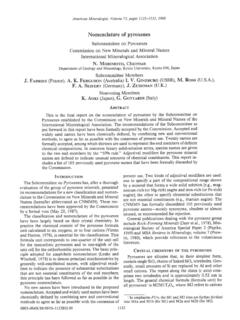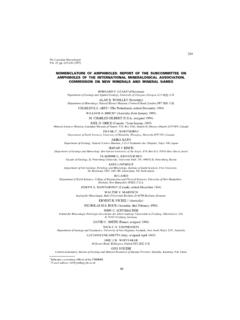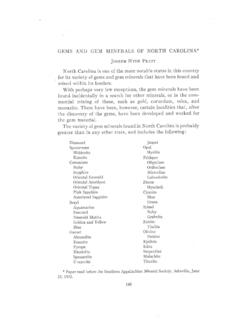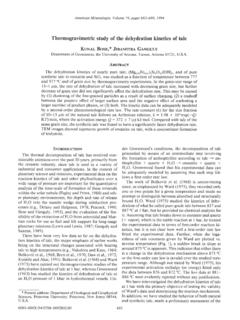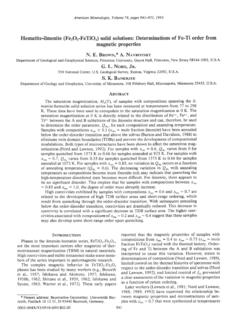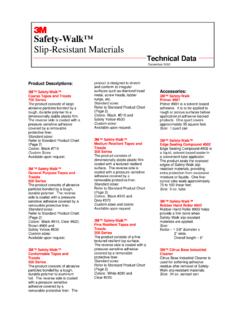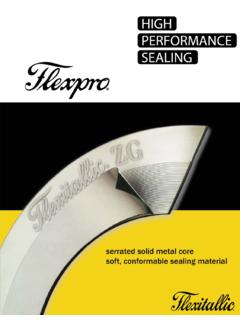Transcription of A LOOK AT PEGMATITE CLASSIFICATIONS Skip …
1 A LOOK AT PEGMATITE CLASSIFICATIONS skip simmons department of Geology and Geophysics, University of New Orleans, New Orleans, Louisiana 70148 USA Modern PEGMATITE classification schemes are strongly influenced by the depth-zone classification of granitic rocks published by Buddington (1959), and the Ginsburg et al. (1979) classification which categorized pegmatites according to their depth of emplacement and relationship to metamorphism and granitic plutons. ern s (1991) revision of that classification scheme (Table 1) is the most widely used classification of pegmatites today.
2 His classification is a combination of depth of emplacement, metamorphic grade and minor element content. His 1991 classification has 4 main categories or Classes. These are Abyssal (high grade, high to low pressure), Muscovite (high pressure, lower temperature), Rare-Element (low temperature and pressure), and Miarolitic (shallow level). The Rare-Element Classes are subdivided based on composition into LCT and NYF types: LCT for Lithium, Cesium, and Tantalum enrichment and NYF for Niobium, Yttrium, and Fluorine enrichment.
3 The Rare-Element Class is further subdivided into types and subtypes according to the mineralogical / geochemical characteristics as shown in Table 2. This scheme has been used in most modern PEGMATITE studies. Many pegmatites fall nicely into these categories, but during the last decade various investigations have revealed pegmatites that don t fit into these categories. Most notably pegmatites of the NYF affiliation have required a more detailed classification as more studies revealed a greater diversity of NYF-type pegmatites.
4 One problem is the classification of some pegmatites as NYF that contain little or no yttrium or others that contain little or no niobium. Many pegmatites from Madagascar described by Pezzotta that are hyper-enriched in Cs don t fall into these categories. Additionally, a number of pegmatites show mixed NYF and LCT characteristic and these are not addressed in the classification . Moreover attempts to relate PEGMATITE types or subtypes to magma genesis or tectonic regimes as has been attempted in granite CLASSIFICATIONS are not satisfactory ( simmons et al.)
5 2003). Also, ern s 1991 classification fails to address the possibility of pegmatites forming by direct anatexis. Consequently, over the last few years several new modifications of ern s classification have been proposed. A few selected examples that illustrate the direction that CLASSIFICATIONS are evolving are presented below. A basic classification for pegmatites of Madagascar (Table 3), based in part on ern 's 1991 classification , was introduced by Pezzotta (2001). This classification retains much of the nomenclature and framework of the older depth-related classification schemes, but is modified by PEGMATITE mineralogy which relates to PEGMATITE bulk chemistry.
6 New types and subtypes were introduced that better represent the compositions of some of the Madagascan pegmatites that are virtually unique. Pezzotta's Class I, the Abyssal Class, applies to pegmatites found at low to high pressure and the highest temperatures. Generally, these pegmatites are poorly mineralized but may contain ceramic materials to make them economically important. Class II, the Rare Element Class, is the most mineralized and most mineralogically diverse. It is subdivided on the basis of a characteristic mineral assemblage for the PEGMATITE .
7 In some cases, a distinction as to NYF and LCT types is specified. Class III, the NYF Miarolitic Class, is based on a low pressure regime. These pegmatites are rich in miarolitic cavities and typically occur at relatively shallow depth. Wise (1999) introduced a new expanded classification of NYF pegmatites (Table 4). His classification relates pegmatites with NYF geochemistry to A-type granite plutons. He related these pegmatites to post-tectonic to anorogenic plutons formed in continental or oceanic rift zones.
8 His classification has three main categories based on aluminum saturation of the parent granite. The three groups are peralkaline, metaluminous, and peraluminous. Within each group, PEGMATITE types are distinguished by mineralogical and geochemical characteristics. This classification is comprised of 6 types and 9 subtypes (Table 4). His classification relates NYF PEGMATITE mineralogy to variations in the alkalinity of the parental granitic melts. Zagorsky, Makagon & Shmakin (1999) proposed a new classification based on pressure, PEGMATITE formation, geochemical / mineralogical sequences, and structural types (Table 5).
9 A point emphasized in this scheme is the observation that miarolitic cavities can occur in all 3 of their types. They propose the idea of a miarolitic facies which can occur in a greater or lesser degree in almost any PEGMATITE sequence. In examining more than 500 PEGMATITE descriptions, Ercit (2004) found a low degree of correlation between accessory mineralogy and depth of emplacement for NYF pegmatites (Table 6). Building on the Wise classification , he proposed that NYF pegmatites belong to the Abyssal, Muscovite-rare-element class, as well as the Rare-element and Miarolitic classes.
10 He also subdivided the abyssal class into two subdivisions: the allanite-monazite-uraninite subtype and the (Y, REE)-Nb-oxide subtype. In the rare element class, the rare earth fluorine type is defined and subdivided into three subdivisions based on HREE vs. LREE and mineralogy: allanite-monazite, euxenite, and gadolinite subtypes (Table 7). A new classification scheme by ern and Ercit (2005) has just been proposed at the GAC/MAC meeting in Halifax, Canada last week and is in press.
